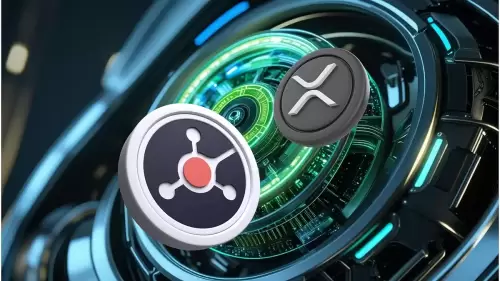 |
|
 |
|
 |
|
 |
|
 |
|
 |
|
 |
|
 |
|
 |
|
 |
|
 |
|
 |
|
 |
|
 |
|
 |
|
Cryptocurrency News Articles
Bittensor is a blockchain that makes mining its main purpose—and abstracts it to such an extent that any digital service can qualify.
May 23, 2025 at 06:30 pm
The blockchain is thereby intended to become a marketplace for machine intelligence. Now, a research startup wants to use it to accelerate the discovery of new drugs.

Bittensor is a blockchain that makes mining its main purpose—and abstracts it to such an extent that any digital service can qualify. The blockchain is thereby intended to become a marketplace for machine intelligence. Now, a research startup wants to use it to accelerate the discovery of new drugs.
Often that’s hot air—even for us it’s hard to determine whether something is bullshit or revolutionary. An example of a story that could be either intriguing or just hot air recently appeared in Forbes: This decentralized AI, the magazine headlines, „could revolutionize drug development.“
What is meant here is a neural network, specifically designed for drug research and decentralized via the Bittensor (TAO) blockchain. This revives an old idea: performing cryptocurrency mining not through “useless” hashes, but through scientific computation. About eight to ten years ago, coins like Gridcoin tried this—without ever succeeding in truly decentralizing scientific mining.
Could it be possible that the combination of modern staking mechanisms and neural networks will finally make this endeavor feasible?
Simulating Chemical Reactions at the Atomic Level
Drug development is typically a very long and arduous process, involving hundreds of steps and taking on average more than 13 years.
However, this process can be simplified and improved using artificial intelligence and molecular simulations. Instead of developing and testing drugs physically, compounds are constructed and simulated in computers. This allows researchers to test more molecular candidates in less time—at least, that is the hope currently permeating the pharmaceutical industry.
In April, Rowan Labs launched a specialized neural network for this purpose called Egret-1. Its goal is to simulate chemical reactions at the atomic level. Until now, this has been incredibly resource-intensive—even scientific supercomputers require a lot of time to realistically simulate just a handful of atoms for a few seconds. Rowan aims to improve this, not by training its neural network on internet data, as ChatGPT does, but by using quantum mechanical equations. The AI learns to reconstruct the results of those equations.
For models like Egret-1 to be successful, however, Rowan explains they require “much more high-quality data generated through density functional theory (DFT). To generate this data, Egret-1 will leverage the decentralized computing power of the Bittensor network to perform these simulations.”
This subnet is part of the Bittensor blockchain (more on that in a moment). The goal is to create a mesh of Bittensors subnets, which are launched by startups. Macrocosmos was established recently, in 2024.
A GROMACS subnet (SN25) is designed to lower the cost of protein folding simulations. It employs the GROMACS standard—to simulate protein folding—but integrates this into a competitive design. This structure incentivizes miners to develop machine-learning models that solve protein folding as efficiently as possible. Validators in the system check miners’ outputs using specific heuristics. The miners who perform best receive tokens from Bittensor—TAO—as a reward.
This competitive process is intended to reduce costs and boost efficiency. Currently, there are 30 active validators simultaneously conducting more than 3,000 simulations; since June 2024, over 400,000 protein folding tasks have already been completed. That’s still far from what AlphaFold accomplishes—but it’s a beginning.
The Abstraction of Mining
To understand Macrocosmos, there’s no way around delving into Bittensor itself. The core idea behind Bittensor is quite fascinating:
One can think of Bitcoin as a decentralized marketplace for digital goods—a market that rewards miners for generating hashes. For Bitcoin, this market is simply a means to an end: securing consensus over a digital ledger (the blockchain) to facilitate a decentralized transaction system. Bittensor, by contrast, makes the digital goods marketplaces an end in themselves.
Bittensor’s core innovation is the separation of the blockchain’s core function (transferring value, etc.) from the operation of the validation system, which defines how the digital goods marketplaces are created. This is important: in classical consensus mechanisms like Proof of Work and Proof of Stake, the consensus algorithm includes the rules for when a consensus-relevant input—a hash or a stake—is valid. Bittensor, however, determines only under which circumstances the consensus itself becomes effective.
The consensus tasks themselves can be written in any language and are validated entirely off-chain—allowing large volumes of data and computing power to be employed. “Bittensor brings the same sort of abstraction that Ethereum added to Bitcoin by introducing smart contracts to Bitcoin’s inverse innovation—the digital marketplaces.”
Just as Ethereum abstracts transaction logic and enables the construction of diverse systems, Bittensor makes it possible to allow even complex and fuzzy mechanisms as consensus work: for example, machine intelligence, protein folding, data storage, model training, and more.
Bittensor does not define the consensus task itself, but rather
Disclaimer:info@kdj.com
The information provided is not trading advice. kdj.com does not assume any responsibility for any investments made based on the information provided in this article. Cryptocurrencies are highly volatile and it is highly recommended that you invest with caution after thorough research!
If you believe that the content used on this website infringes your copyright, please contact us immediately (info@kdj.com) and we will delete it promptly.




























































